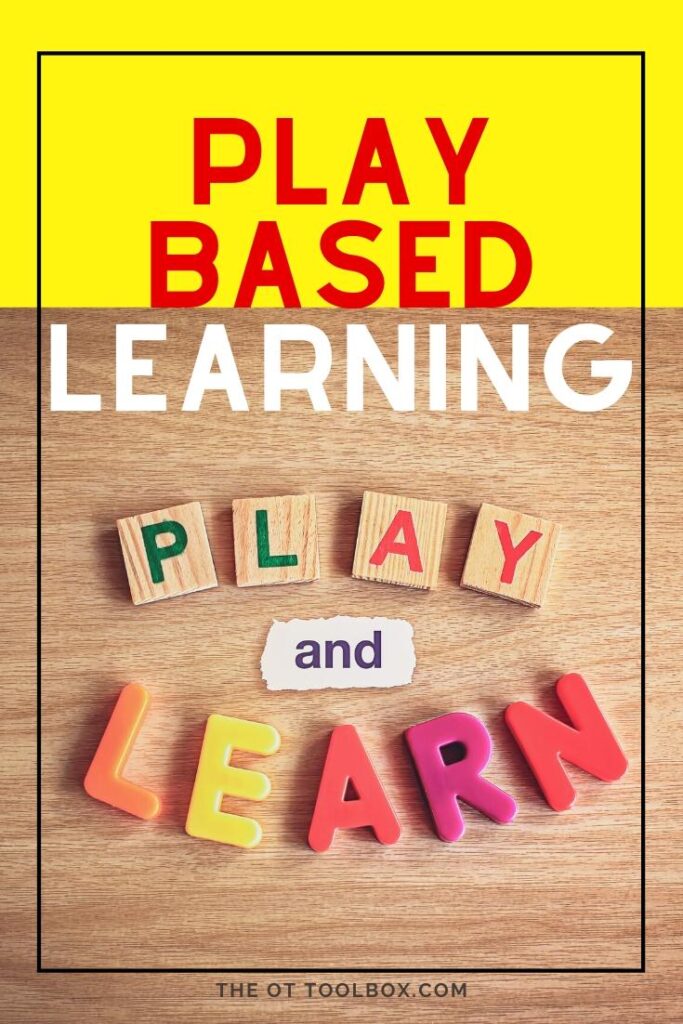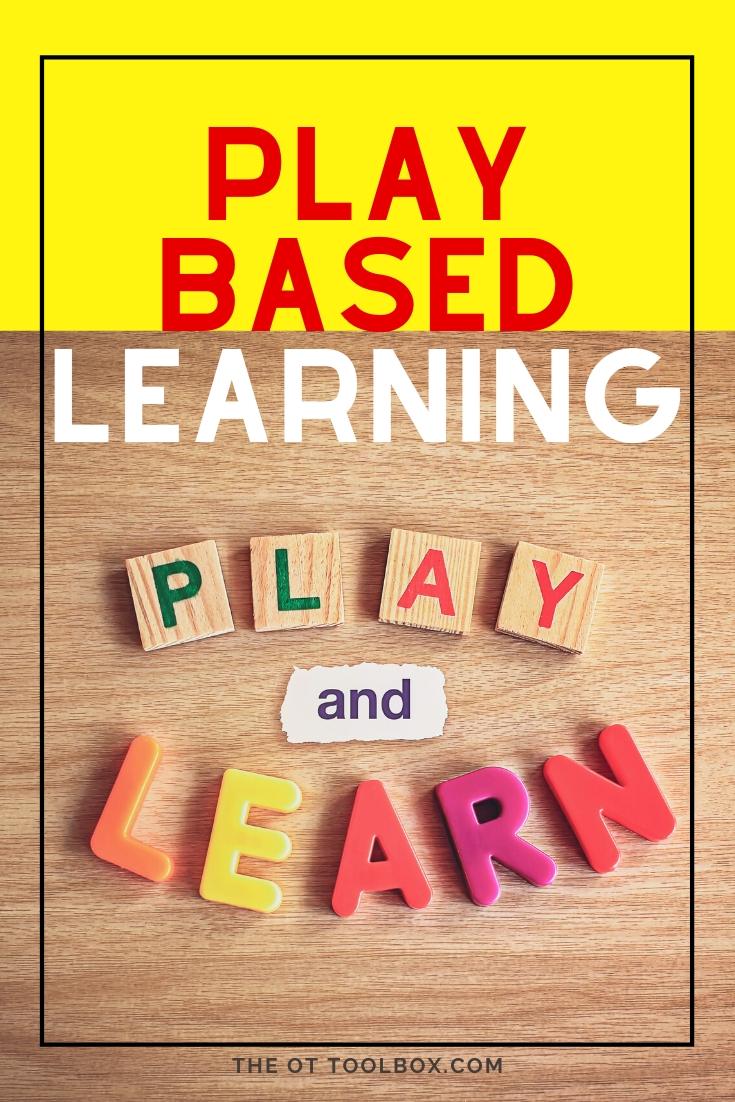Play based learning is a powerful tool! Today, we are discussing how and why a creative play that combines movement and visual processing skills impact learning and development. We’ll cover using learning and play with movement-based learning through play ideas using brain breaks. We’ll also share interactive learning opportunities that address motor, cognitive, social, emotional, sensory, and emotional needs.
This content is part of our week-long therapy giveaway event, where we are collaborating with brands to give you the opportunity to win various therapy items, toys, and games as a thank you for being here and a celebration of our profession and those we serve. This giveaway has now ended.

Play Based Learning
What is play-based learning, and why is learning through play important for kids? Why is it that children learn through play?
Play based learning offers many opportunities to advance on cognitive skills through the process of play. By using skills that the child is familiar with and confidence in, they can excel in learning concepts by simply playing.
While play offers the opportunity to build and advance on skills like motor development, executive functioning, problem solving, visual processing, and other areas. But play also offers situations to expand on self-regulation as well. By incorporating play into a learning experience, children get the chance to move. It’s a brain break built right into learning.
Learning through Play
Learning and thriving as a child, according to Kathryn Hirsh-Pasek, a well-known child development expert notes that children require the “six C’s” in order to succeed. These are six attributes that must exist in order for children to thrive. Through that success comes learning. These aspects build on one another and allow function and success for the child. The six attributes for successful thriving are as follows:
- collaboration
- communication
- content
- critical thinking
- creative innovation
- confidence
By building these areas as well as using these attributes in learning opportunities, we give our children the opportunity to succeed in learning. Don’t these attributes sound like aspects of play? Through play, kids collaborate with others. They interact in play situations in games and pretend play. They communicate with peers or through self-talk. They participate in real-life situations and carry those situations over into play as they “chew on” things that occur around them in the real world. They might pretend to go to the grocery store, drive a truck, take care of a baby, or be a teacher. They see the content and practice it by playing. Play is a chance to practice and expand on critical thinking. It’s a chance to expand on attention, problem solving, working memory and other essential skills. Creative innovation happens during the play process and as a result, creative innovation. All of these skills happen through play and are essential for learning as well. When the processes are combined by true engagement in play AND learning, real skills can be developed and built upon. Play is a powerful tool for learning!
Learning through play allows the learning situation to become active and not passive. It allows us to take a meaningful part in the learning process rather than sitting back and soaking in information. Play offers the freedom to participate in meaningful learning situations that are memorable.
By adding movement, games, or play situations into learning facts, the connections between physical education, movement, breaks, recess, energizing activities, and improved cognition strengthen. In fact, movement can be an effective cognitive strategy to (1) strengthen learning, (2) improve memory and retrieval, and (3) enhance learner motivation and morale.
Movement and Learning in Play
Brain breaks are a buzzword in the schools. But the facts are that kids are receiving less recess time, increased demands in the classroom, and have less outdoor play at home. When those factors align, it’s a recipe for disaster. The thing is that movement breaks in the classroom, or “brain breaks” offer kids the chance to reset. They can help to prepare the nervous system for learning. They can also be done in between learning activities or combined with learning situations to support self-regulation while children are engaged in an academic or learning task.
Movement, standing up, stretches, yoga breaks, and activity are powerful tools! As noted in Teaching with the Brain in Mind, by Eric Jensen:
“These actions can raise a child’s heart rate (and as a result, blood flow) by as much as 5 to 8 percent in just seconds (Krock & Hartung, 1992). And finally, here’s a powerful research finding: evidence from animal studies indicates that voluntary exercise influences gene expression to improve learning and memory (Tong, Shen, Perreau, Balazs, & Cotman, 2001). This improved pattern of gene expression enhances many factors that support the encoding and transfer of data, synaptic structure, and the activity and plasticity of neurons. All of these processes facilitate learning.”
Play Based Learning Activities
So knowing all of this, how can we combine play with learning in the classroom to build concepts, practice math facts, memorize vocabulary words, practice comprehension, and other essential learning tasks?
Adding opportunities to move during classroom times offers just the freedom for the facilitation of learning, all while offering the means to move and get the child in the “just right” state of regulation for absorbing information.
One tool for offering learning through play is by using an open-ended means of combining learning with games and movement activity.
Learning Through Play Activity
Adding movement to classroom learning by using games and gross motor actions offers a brain break opportunity. Some ideas include those that incorporate gross motor movement into math when repeating facts. These allow whole-body games such as Simon Says.
Students can perform specific motions when math facts are true, and perform other motor tasks when math facts are false. Try asking kids to jump or do jumping jacks for an up and down motion.
Bounce a beach ball in a game or at a target to encourage eye-hand coordination while practicing facts or stating true/false responses.
Add upside down motions in the classroom for a calming activity or one that “resets” sensory modulation. Students can sit in their seat and reach under one side to place an object at the far side of their chair, putting their head in an inverted position. Try placing index cards with facts, spelling words, or statements into piles on each side of the chair.
Toss balls at a target with answers.
Add movement games and songs into learning with tunes like “Head Shoulders Knees and Toes”.
Bend over at the knees and place cards, post-it notes, or items into a target. Add over or under movements with specific answers or true/false responses.
Sit on a target and spin around to each as far behind as the child can to add rotary movements. They can place balls into a target as the answer. Make it part of a relay or timed response with a team as they answer questions.
Use this PlaySet to build on learning in the classroom. The numbers can be assigned to answers or used in math activities. Add movement and play to learning by using the play set in gross motor activities, self-regulation and sensory modulation activities, motor planning, and emotional regulation activities, or other learning through play activities.
- 1 PunkinPlaySpace
- 3 Orange PunkinPitch Balls
- 3 Blue PunkinPitch Balls
- 1 Durable Vinyl Storage Pack
Play ANd Learn Play Space GIVEAWAY
This giveaway has now ended.
Play Based Learning Ideas
Some of the smartest and most creative folks I know are the readers of The OT Toolbox. I asked readers to tell me sensory strategies they personally love and use to address sensory modulation. Scroll through the comments…you might just find some new sensory strategies that will work for you! Hopefully we can learn from one another!
Also, check out these other soy suggestions based on therapeutic development through play.
- Fine Motor Toys
- Gross Motor Toys
- Pencil Grasp Toys
- Toys for Reluctant Writers
- Toys for Spatial Awareness
- Toys for Visual Tracking
- Toys for Sensory Play
- Bilateral Coordination Toys
- Games for Executive Functioning Skills
- Toys and Tools to Improve Visual Perception
- Toys to Help with Scissors Skills
- Toys for Attention and Focus
Then, scroll through the comments…you might just find some new learning through play activities that will work for you! Hopefully we can learn from one another!



